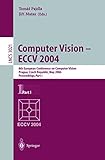Computer Vision - ECCV 2004 [electronic resource] : 8th European Conference on Computer Vision, Prague, Czech Republic, May 11-14, 2004. Proceedings, Part I / edited by Tomás Pajdla, Jiří Matas.
Material type: TextSeries: Lecture Notes in Computer Science ; 3021Publisher: Berlin, Heidelberg : Springer Berlin Heidelberg, 2004Description: XXVIII, 640 p. online resourceContent type: text Media type: computer Carrier type: online resourceISBN: 9783540246701Subject(s): Computer science | Artificial intelligence | Computer graphics | Computer vision | Optical pattern recognition | Computer Science | Image Processing and Computer Vision | Pattern Recognition | Computer Graphics | Artificial Intelligence (incl. Robotics)Additional physical formats: Printed edition:: No titleDDC classification: 006.6 | 006.37 LOC classification: TA1637-1638TA1637-1638Online resources: Click here to access online
TextSeries: Lecture Notes in Computer Science ; 3021Publisher: Berlin, Heidelberg : Springer Berlin Heidelberg, 2004Description: XXVIII, 640 p. online resourceContent type: text Media type: computer Carrier type: online resourceISBN: 9783540246701Subject(s): Computer science | Artificial intelligence | Computer graphics | Computer vision | Optical pattern recognition | Computer Science | Image Processing and Computer Vision | Pattern Recognition | Computer Graphics | Artificial Intelligence (incl. Robotics)Additional physical formats: Printed edition:: No titleDDC classification: 006.6 | 006.37 LOC classification: TA1637-1638TA1637-1638Online resources: Click here to access online  E-BOOKS
E-BOOKS
| Current library | Home library | Call number | Materials specified | URL | Status | Date due | Barcode |
|---|---|---|---|---|---|---|---|
| IMSc Library | IMSc Library | Link to resource | Available | EBK3121 |
Tracking I -- A Unified Algebraic Approach to 2-D and 3-D Motion Segmentation -- Enhancing Particle Filters Using Local Likelihood Sampling -- A Boosted Particle Filter: Multitarget Detection and Tracking -- Feature-Based Object Detection and Recognition I -- Simultaneous Object Recognition and Segmentation by Image Exploration -- Recognition by Probabilistic Hypothesis Construction -- Human Detection Based on a Probabilistic Assembly of Robust Part Detectors -- Posters I -- Model Selection for Range Segmentation of Curved Objects -- High-Contrast Color-Stripe Pattern for Rapid Structured-Light Range Imaging -- Using Inter-feature-Line Consistencies for Sequence-Based Object Recognition -- Discriminant Analysis on Embedded Manifold -- Multiscale Inverse Compositional Alignment for Subdivision Surface Maps -- A Fourier Theory for Cast Shadows -- Surface Reconstruction by Propagating 3D Stereo Data in Multiple 2D Images -- Visibility Analysis and Sensor Planning in Dynamic Environments -- Camera Calibration from the Quasi-affine Invariance of Two Parallel Circles -- Texton Correlation for Recognition -- Multiple View Feature Descriptors from Image Sequences via Kernel Principal Component Analysis -- An Affine Invariant Salient Region Detector -- A Visual Category Filter for Google Images -- Scene and Motion Reconstruction from Defocused and Motion-Blurred Images via Anisotropic Diffusion -- Semantics Discovery for Image Indexing -- Hand Gesture Recognition within a Linguistics-Based Framework -- Line Geometry for 3D Shape Understanding and Reconstruction -- Extending Interrupted Feature Point Tracking for 3-D Affine Reconstruction -- Many-to-Many Feature Matching Using Spherical Coding of Directed Graphs -- Coupled-Contour Tracking through Non-orthogonal Projections and Fusion for Echocardiography -- A Statistical Model for General Contextual Object Recognition -- Reconstruction from Projections Using Grassmann Tensors -- Co-operative Multi-target Tracking and Classification -- A Linguistic Feature Vector for the Visual Interpretation of Sign Language -- Fast Object Detection with Occlusions -- Pose Estimation of Free-Form Objects -- Interactive Image Segmentation Using an Adaptive GMMRF Model -- Can We Consider Central Catadioptric Cameras and Fisheye Cameras within a Unified Imaging Model -- Image Clustering with Metric, Local Linear Structure, and Affine Symmetry -- Face Recognition with Local Binary Patterns -- Steering in Scale Space to Optimally Detect Image Structures -- Hand Motion from 3D Point Trajectories and a Smooth Surface Model -- A Robust Probabilistic Estimation Framework for Parametric Image Models -- Keyframe Selection for Camera Motion and Structure Estimation from Multiple Views -- Omnidirectional Vision: Unified Model Using Conformal Geometry -- A Robust Algorithm for Characterizing Anisotropic Local Structures -- Dimensionality Reduction by Canonical Contextual Correlation Projections -- Illumination, Reflectance, and Reflection -- Accuracy of Spherical Harmonic Approximations for Images of Lambertian Objects under Far and Near Lighting -- Characterization of Human Faces under Illumination Variations Using Rank, Integrability, and Symmetry Constraints -- User Assisted Separation of Reflections from a Single Image Using a Sparsity Prior -- The Quality of Catadioptric Imaging – Application to Omnidirectional Stereo.
Welcome to the proceedings of the 8th European Conference on Computer - sion! Following a very successful ECCV 2002, the response to our call for papers was almost equally strong – 555 papers were submitted. We accepted 41 papers for oral and 149 papers for poster presentation. Several innovations were introduced into the review process. First, the n- ber of program committee members was increased to reduce their review load. We managed to assign to program committee members no more than 12 papers. Second, we adopted a paper ranking system. Program committee members were asked to rank all the papers assigned to them, even those that were reviewed by additional reviewers. Third, we allowed authors to respond to the reviews consolidated in a discussion involving the area chair and the reviewers. Fourth, thereports,thereviews,andtheresponsesweremadeavailabletotheauthorsas well as to the program committee members. Our aim was to provide the authors with maximal feedback and to let the program committee members know how authors reacted to their reviews and how their reviews were or were not re?ected in the ?nal decision. Finally, we reduced the length of reviewed papers from 15 to 12 pages. ThepreparationofECCV2004wentsmoothlythankstothee?ortsofthe- ganizing committee, the area chairs, the program committee, and the reviewers. We are indebted to Anders Heyden, Mads Nielsen, and Henrik J. Nielsen for passing on ECCV traditions and to Dominique Asselineau from ENST/TSI who kindly provided his GestRFIA conference software. We thank Jan-Olof Eklundh and Andrew Zisserman for encouraging us to organize ECCV 2004 in Prague.


There are no comments on this title.